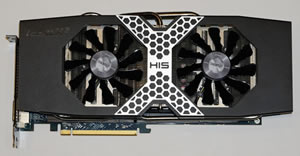HIS Radeon HD 7850 4GB iPower IceQ Turbo, Radeon HD 7950 IceQ X2
11. Final words
Review Pages
2. Meet the HIS Radeon HD 7850 4GB iPower IceQ Turbo
3. Meet the HIS Radeon HD 7950 IceQ X2
4. Test setup
5. DirectX 11: 3D Mark 11, 3DMark 2013
6. DirectX 11: Crysis 3, Hitman Absolution
7. DirectX 11: Far Cry 3, Final Fantasy
8. DirectX 11: Alien Vs Predator, Sleeping Dogs
9. DirectX 11: Tomb Rider, Sniper Elite V2
10. Overclocking
11. Final words
The HIS 7850 iPower IceQ Turbo 4GB graphics comes armed with 4GB graphics memory, a custom PCB and cooler and it is factory overclocked.
Starting with the extra memory, the 4GB sound great in theory although we are not sure this huge framebuffer will actually offer you any significant benefits, at least for a mid-range graphics card that will not be part of a high-end gaming system. Of course, if you are planning to go beyond the 2560x1600 resolutions and very high AA levels, the extra memory would help.
The custom cooler onboard seems to be efficient enough to keep your card running smoothly even in Crossfire configurations. Temperatures under idle are low and the airflow coming through the card's fan is barely audible. UNder more stressful conditions or a Crossfire configuration, the cards stay under 68 Degrees C while the noise level is less than 40 dBA.
Regarding performance, the HIS 7850 iPower IceQ Turbo 4GB delivers exactly what it is supposed to, with decent FPS in most games and in full-HD resolutions, and a general performance on average in par with what you might expect from a an Nvidia GeForce GTX 760. Installing two HIS 7850 cards in Crossfire mode is also a good option for more demanding users.
The cards is factory overclocked so do not expect any further tweaks. Powered by two 6-pin power headers and a GPU frequency lock at 1050 MHz, there is not much headroom for impressive gains.
To sum up, the HIS 7850 iPower IceQ Turbo 4GB graphics card is priced at $250 mainly due to its 2GB extra memory onboard, compared to a $200 2GB version. We are not sure the deal is great, unless you desperately need to play your games in very high resolutions. Other wise, the HD 7850 2GB version or the HD 7870 2GB will cost you $50 less.

The HIS Radeon HD 7950 IceQ X² Boost Clock 3GB features a custom PCB and cooling, and it is factory overclocked at 950 MHz.
At a first glance, this card is lengthy, so be sure to check out that it'll fit inside your chassis with its 31cm / 12.2 inches length.
It's dual-fan IceQ X² cooler is performing pretty well, with the idle levels to be in the 30 Degrees C range and and at 60 Degrees C under stress. Noise levels are also very acceptable.
Performance figures are also impressive, with the 7950 IceQ X² Boost edition to deliver FPS that sometimes reach the levels of more expensive cards. For instance, we measured more than 35 average FPS at Crysis 3 in 1920x1200 at Very High Quality and FXAA.
Overclocking also returned some good results. The card reached the 1150 MHz with just a few tweaks and great stability. All we did was to
increase power limiter, voltage and the fan speed. The result was a great
10~15% in performance.
For around $310-320 you get a very good graphics card that can play all the latest games at acceptable image quality settings at a resolution of 1920x1080/1200.
 |
 |
